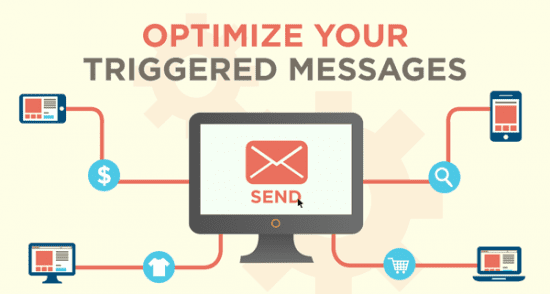Optimising your triggered messages - 7 common Mistakes to avoid
Sending triggered email messages or behavioural email marketing is a proven method for improving customer engagement and increasing sales for retailers. However, there is a lot of confusion as to what types of ‘on-site’ behaviours should trigger a message, how it should look and feel, as well as how best to measure the results. There is a big difference between doing the right things and doing things right, so here is a simple yet comprehensive overview that will help you to optimise your triggered messages.

Using the right triggers for your messages
Ask people what constitutes a trigger and the first and often only response will be a shopping cart abandonment. However, these people are missing a trick and limiting their reach by not embracing browse abandonment.
This doesn’t necessarily mean targeting every visitor who leaves without placing an item in a basket without checking out. You may wish to base your criteria on those who viewed certain products or categories.
It is also important to note that high value / once in a lifetime products (where there is a need for deeper engagement between the customer and the organisation), warrants a different approach to browse abandonment. Using real-time customer profiling on your site will ensure that the ‘triggers’ of these particular visitors are identified and relevant message can be sent.
By using browse abandonment as an additional trigger it has been proven to deliver an extra 3% return on top of a more ‘traditional’ cart-only approach.
Knowing what should trigger a message is vital, but it is also worth being mindful of online behaviours that should not. I am talking about people who simultaneously browse sites across multiple devices.
A visitor flipping from a smartphone to a laptop should not receive a message as they have not abandoned (they may simply be opting for a larger on-screen display of your products). Only if they leave altogether without making a purchase should a message be sent - especially if your message includes an incentive in the form of a voucher code! This leads nicely to one of the most common questions…
To discount, or not to discount?
It may make logical sense to include an enticement back to the website to complete an abandoned transaction. However, price may not have been the cause for their abandonment.
In a recent test (more on the importance of testing later) a retailer included a 15% coupon in their triggered messages and the results where fascinating. No nobody likes to pay more than they have to, so when the discount was offered it actually changed the behaviour with immediate buyers becoming delayed buyers. Visitors would intentionally abandon knowing that they would receive the offer soon after. In fact, this tactic has become the topic of a recent television ad by Barclays. So, by looking at the results of their triggered messages in isolation you would think they had the perfect optimised strategy. But the truth was very different and overall sales where not improving.
However, creating urgency in a message can be a highly effective technique. If, for example the visitor was looking at a sale item which is due to end, then using a countdown timers to highlight how long they have to get the product at that price, can have a huge impact on click through rates and completed sales.
Avoiding the common mistakes
Blanket couponing is just one of a number of common mistakes that we often see having a big impact on the effectiveness of a triggered message. Others prime for optimising include…
- A lack of personalisation (not just the salutation but also the content)
- Not making the message instantly recognisable in the inbox
- The message is vague and overly long, with no clear call to action
- Failing to include images. Picture reminders of the products left in the shopping cart, as well as items they may be interested in based on browsing session history, or crowd-sourced trends
- Not conveying the right tone of voice and brand image. Monitor your competitors, including those who aspire to be in your market position and those who your organisation aspires to topple. What do their emails look like? What copy are they using? Would it resonate with your customers?
- Including navigation within the message. This creates an unnecessary distraction from the course of action you wish the recipient to take
- Failing to adapt to layout revisions by web-mail providers and new hardware devices, impacting the style of the message. For example, if your customer-base are the type of people to have an Apple Watch, then you message needs to be optimised for its tiny display.
Another big issue is timing and specifically sending the message too late. This problem is often caused by ESP solution providers that have set times for distribution. Ideally, the message needs to be delivered within 23 hours of the session being abandoned for it to have relevance.
However, I would stress that relevance is, to a far greater extent, dictated by the time the recipient reads rather than receives the message. Real-time email content solutions provide a way to optimise content to ensure that what the recipient reads is most likely to be relevant to them at that exact moment in time.
Tracking
Of course, the cornerstone for any triggered messages is making sure that you have the necessary information to be able to send a message in the first instance. This is not a problem if the visitor has logged in, but often this is done as they approach checkout, meaning you have missed all their prior activity that could have an impact on the content of your message.
Ideally, you want to be able to track their activity before sign-in.
This can be achieved through the use of pop-ups during the session inviting them to give their email address, encouraging early sign-in, as well as tracking if they have clicked through from an electronic communication to them.
You can’t manage what you can’t measure
Optimisation isn’t a one-off project it needs continual measurement and that means you need to clearly define what constitutes success. Sounds obvious! Yet many ESP solutions measure metrics such as clicks and opens, and whilst these are interesting, what you really need to know is ultimately how many purchases have been made as a result of your blood, sweat and tears.
There are two approaches you can take for ongoing testing. The first involves running one type of message one week and another a week later and measuring the difference. The other is a split test whereby 50% of visitors to the website receive one type of message and the remaining half a different type. Both have their pluses and minuses, but the key takeaway is no matter how you choose to test, it is the fact that you are testing in a consistent and continual manner that is key.
Also, don’t be afraid to make changes to your messages! Evidence suggests that any changes you make (of course within reason) are likely to have a positive impact. So, review and refresh regularly.
Finally, remember that by optimising your triggered messages you are increasing your chances of success, but for optimal performance you need to optimise all of your e-marketing and communications activities.

Thanks to
Mike Austin for sharing their advice and opinions in this post. Mike Austin is a technologist with 14 years experience of email marketing. He co-founded an ESP in 2000 and co-founded
Triggered Messaging in 2011. You can connect on
LinkedIn.




 Thanks to
Thanks to 


